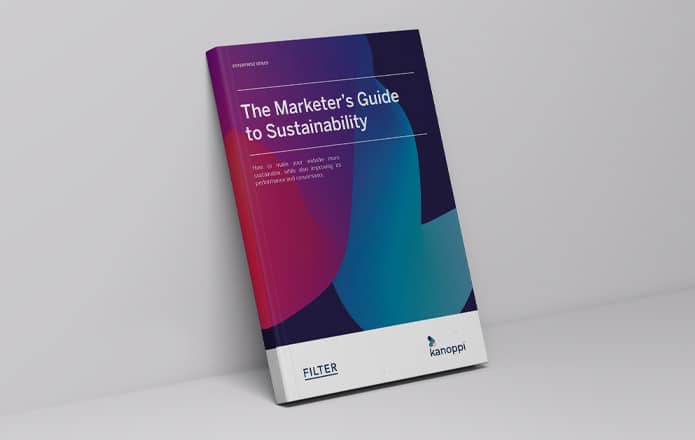
In this article, we’ll guide you through how to measure your site’s carbon footprint, and explain how reducing this will improve both sustainability and performance.

The technology sector is responsible for more greenhouse gas emissions than the aviation industry. Each time a visitor lands on your website and loads up a page, it contributes to these emissions. And you may be shocked to learn just how much of a carbon footprint your website is currently leaving behind.
In this article, we’ll guide you through how to measure your site’s carbon footprint, and explain how reducing this will improve both sustainability and performance.
Like many people we speak to, you may be surprised to learn your website has a fairly big carbon footprint.
In fact, most people don’t realise that if the Internet was a country, it would be the world’s fourth biggest polluter. And what is the Internet made up of? Hundreds of millions of active websites, of course.
Whenever someone accesses your site, the server the site is hosted on has to consume energy and, as a result, emits greenhouse gases. Each time someone lands on a web page, this incites a transmission of data from server to device, and this has an impact on the environment.
When you consider the amount of traffic that passes through all the websites on the Internet each day, it all adds up to a pretty serious problem.
Becoming more conscious of your website’s carbon footprint is important for a number of reasons. First of all, because all these emissions are damaging the environment and fuelling climate change.
Climate change is expected to cause an additional 250,000 deaths per year between 2030 and 2050. By making small changes in our web design, development, and management practices, the digital community can play a role in helping prevent that.
However, we appreciate that in the business world these moral values often come second to producing results, especially in revenue-related areas like marketing and sales.
Even if your business doesn’t have sustainability as a key goal, there are other reasons why you should proactively look to measure and reduce your carbon footprint.
Perhaps the most beneficial one to the business is that an energy-efficient website is often a high-performing website. The faster and leaner your site, the better your user experience (UX). Naturally, improving your UX will have a positive impact on your business and help you grow.
There are also going to be legal implications coming up for businesses who maintain bad sustainability practices, following the recent release of the Web Sustainability Guidelines (WSG) 1.0. As sustainability becomes an increasingly important global priority, more scrutiny is being directed at the digital sector.
That’s all without even mentioning the harm your brand’s reputation could suffer if you neglect the responsibility of reducing your carbon emissions. As 75% of adults in the UK now care about climate change, this will become an increasingly important consideration for businesses over the coming years.

Download our FREE guide to digital sustainability to access key insights, created in collaboration with the industry experts behind Kanoppi.
Before you can reduce your site’s carbon footprint, you have to measure it. To measure it, you have to understand what causes it.
So, let’s quickly cover the main causes of high emissions from websites:
These factors all contribute to both the sustainability and the performance of your website.
For example, stuffing a web page full of large media files, embedding videos that auto-play on every user’s device, and leaving high volumes of redundant code present on the page will all contribute to an extremely bloated page weight. A high page weight consumes a lot more energy. It will also be slower to load, giving your visitors a poor UX.
To measure these factors and determine the tangible carbon footprint of your own website, there are some simple things you can do:
Speak to your hosting provider about their practices and values. You should ask them about the servers they use, and whether they qualify for “green hosting” or not. An important metric to look into is the power usage effectiveness (PUE) of their data centres.
If you’re using just one server to store and transmit all data to all your users across the globe, you’re taking a less energy-efficient approach than you could be.
There are plenty of sustainability-focused services and resources online that list and recommend hosting providers that use sustainable practices.
If you use a lot of images, videos, animation, and complex design elements on your site, chances are your site has a fairly big carbon footprint. You might be able to tell this already from your own experience reviewing or testing your pages, but it’s important to identify the specific pages with the most issues.
To measure the tangible load speeds of your web pages, there are intelligent tools available. Google’s PageSpeed Insights and GTmetrix will tell you how performant your site is and offer suggestions for optimisation.
If you have in-house developers or other team members who work with your site’s code, they may be using development practices that aren’t aligned with sustainability.
There are useful tools available for measuring the efficiency of your site’s code as well, such as Google’s Lighthouse.
There are several things you should be monitoring all the time.
The response time of your server, and the speed at which it transmits data to the browser on your users’ devices, are indications of your site’s efficiency. Inefficient data transmission often comes from sub-optimal pages, which also indicates poor performance.
You should also continuously monitor the weight and speed of each individual page across your site. Look into important metrics like pages with the heaviest page weight, and also pages that receive the most traffic. The pages that receive high traffic volumes will be using energy from the server most often, so it’s important these are optimised to reduce the emissions your site produces.
You can also conduct regular audits of your site’s overall carbon footprint, often measured in kilograms of CO2. There are some great services and tools available that help businesses to monitor, measure, and optimise their impact on the environment, such as Kanoppi for WordPress users.
Once you’ve measured the impact your site is having on the environment, you can begin to optimise and become more sustainable.
Some simple steps you can take to reduce your site’s emissions and improve its performance include:
Another useful way to ensure you’re minimising your site’s carbon footprint is to keep up with industry standards, trends, and guidelines for sustainability.
As sustainability is such a complex issue, and technology is continuing to advance at such a rapid pace, you should treat this as a continuous process of learning and improvement. Of course, there’s a lot more to this issue than we can cover in just one blog article.
You can learn more about how to improve your site’s performance and sustainability in our latest guide, The Marketer’s Guide to Sustainability.
Written in partnership with Kanoppi, this guide will help you to:
Of course, you can also get in touch with us directly if you have any questions or need any more help.
Here is a list of helpful resources to support you on your journey to becoming more sustainable.